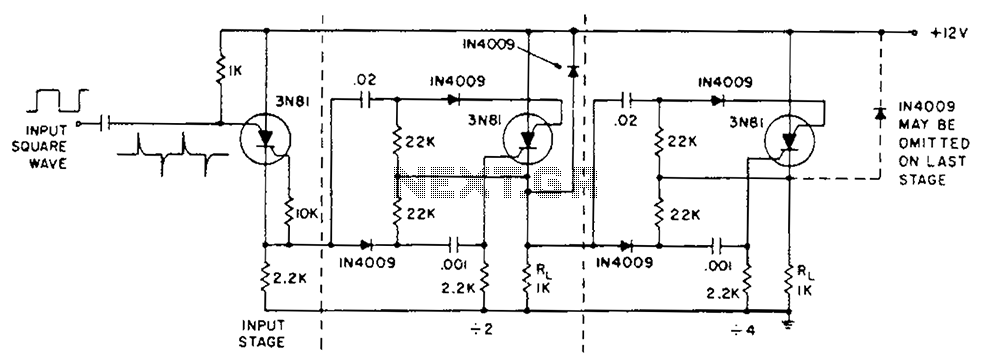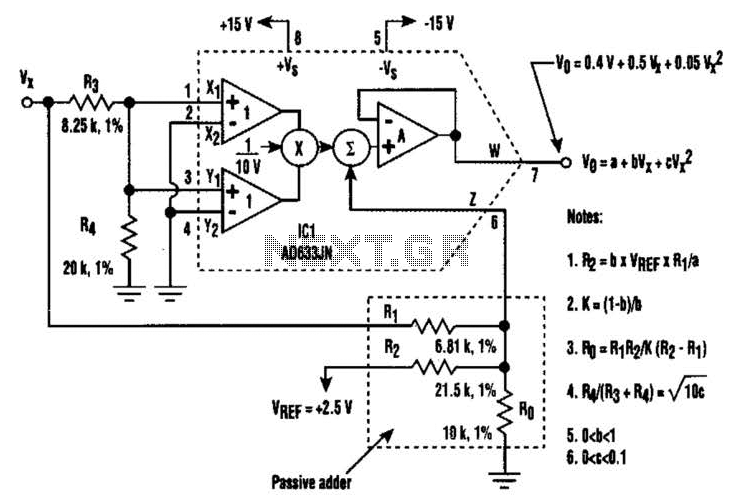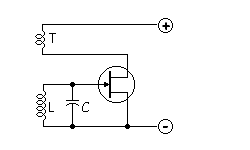
Binary counter circuit diagram

The circuit operation is initiated by a positive edge signal. The anodes of the triac switches are activated while the cathodes of the switches remain closed. A male-female IN4009 diode is utilized for positive transient suppression, ensuring that the primary function of the thyristor switch is maintained. To trigger a counter, the input stage is capable of generating rapid positive transitions.
The described circuit is designed to operate with a triac configuration, which is commonly employed for controlling AC loads. The activation of the triac occurs upon receiving a positive edge signal at its gate terminal, allowing current to flow from the anode to the cathode. The diodes, specifically the IN4009, are strategically placed to provide transient suppression, protecting the circuit from voltage spikes that may occur during operation. This suppression is critical in maintaining the integrity and functionality of the thyristor switch, which acts as a key component in regulating power flow.
In the context of triggering a counter, the input stage of the circuit is engineered to produce rapid positive transitions. This is essential for ensuring that the counter accurately registers each event or pulse generated by the circuit. The design may include additional components such as capacitors to filter noise and resistors to set the appropriate timing characteristics, ensuring reliable performance.
Overall, the circuit's configuration allows for effective control and monitoring of AC loads, leveraging the properties of triacs and diodes to enhance operational stability and response time. Proper attention to component selection and circuit layout will further optimize the performance and reliability of the system. Circuit order is triggered by the positive edge. The anode of the triac switches are turned on, the cathode of the switches are closed. Male - female IN4009 positive transient suppression, and the main function of the thyristor switch is restored. In order to trigger a counter, the input stage can produce rapid positive direction.
The described circuit is designed to operate with a triac configuration, which is commonly employed for controlling AC loads. The activation of the triac occurs upon receiving a positive edge signal at its gate terminal, allowing current to flow from the anode to the cathode. The diodes, specifically the IN4009, are strategically placed to provide transient suppression, protecting the circuit from voltage spikes that may occur during operation. This suppression is critical in maintaining the integrity and functionality of the thyristor switch, which acts as a key component in regulating power flow.
In the context of triggering a counter, the input stage of the circuit is engineered to produce rapid positive transitions. This is essential for ensuring that the counter accurately registers each event or pulse generated by the circuit. The design may include additional components such as capacitors to filter noise and resistors to set the appropriate timing characteristics, ensuring reliable performance.
Overall, the circuit's configuration allows for effective control and monitoring of AC loads, leveraging the properties of triacs and diodes to enhance operational stability and response time. Proper attention to component selection and circuit layout will further optimize the performance and reliability of the system. Circuit order is triggered by the positive edge. The anode of the triac switches are turned on, the cathode of the switches are closed. Male - female IN4009 positive transient suppression, and the main function of the thyristor switch is restored. In order to trigger a counter, the input stage can produce rapid positive direction.





